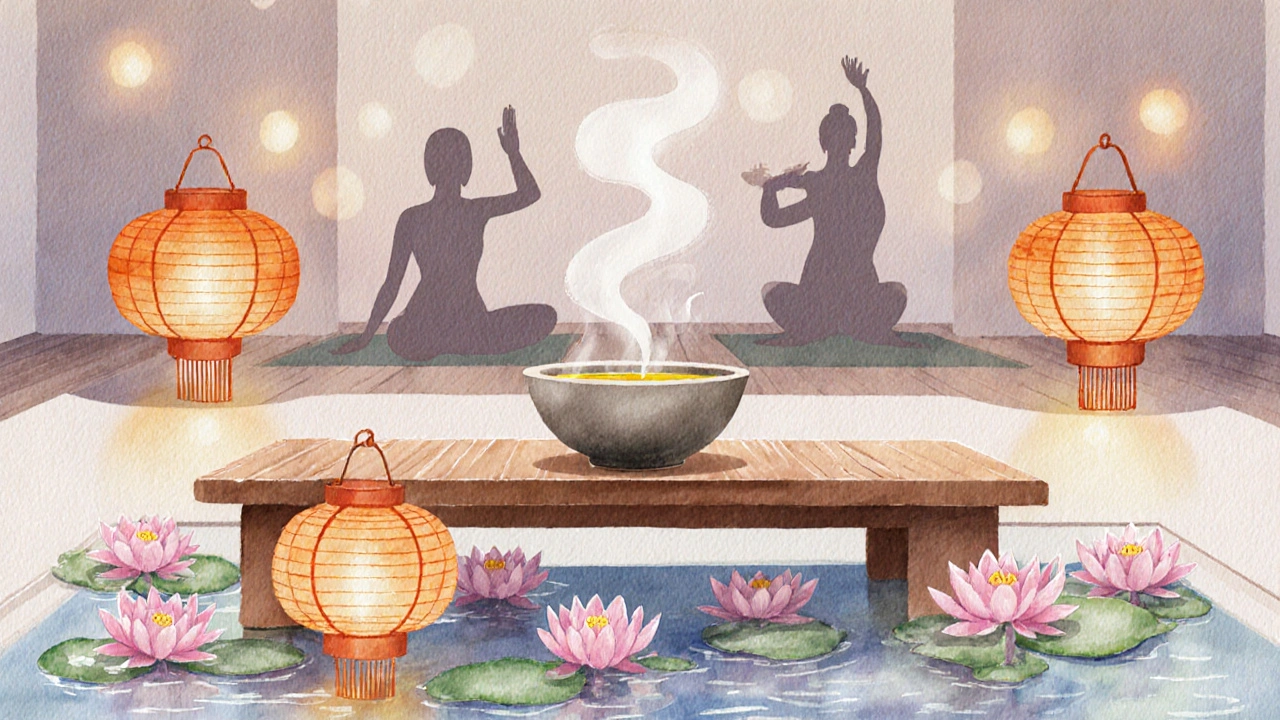Asian Erotic Massage Legal Status Checker
Check Legal Status
Important Notes
Legal status can vary significantly by neighborhood and may change frequently. Always verify current local laws before booking. In many places, what appears legal may still be considered a form of prostitution depending on local interpretation.
Check for official permits - Reputable establishments often display health certificates and business licenses. If a provider can't show proper documentation, it's a red flag.
Legal Status Results
When you hear Asian erotic massage, a flood of images, rumors, and judgments often pop up. People wonder whether it’s a legitimate wellness service, a hidden side of the sex industry, or just a myth fueled by movies. This article cuts through the noise, explains what the service actually entails, maps out the legal landscape, and shows how cultural attitudes shape the experience for both clients and therapists.
Key Takeaways
- Asian erotic massage blends traditional bodywork with consensual sexual intimacy, but it varies widely by location.
- Legal status ranges from fully regulated in some regions to outright illegal in others; knowing local laws is crucial.
- Cultural stigma often pushes the industry underground, affecting safety and health standards.
- Clear communication, consent, and hygiene are the pillars of ethical practice.
- Clients who respect boundaries and therapists who set firm rules create a healthier environment for everyone.
What Is Asian Erotic Massage?
Asian erotic massage is a type of bodywork that originated in East Asian cultures and incorporates sensual touch, erotic stimulation, and often a sexual climax for the client. Unlike a standard therapeutic massage aimed solely at muscle relief, this service adds a sexual component that is consensual and paid for as part of the session.
Another term you’ll hear is erotic massage, which refers to the broader practice of integrating sexual arousal into massage. While erotic massage can be found worldwide, the “Asian” label usually signals influences from traditional techniques such as Thai yoga massage, Chinese tui na, or Japanese anma, combined with modern erotic services.
Clients seek these experiences for many reasons: stress relief, exploration of sexuality, or a desire for intimate connection that feels safe and professional. Therapists often advertise a calming environment, scented oils, and a focus on the whole-body experience rather than a purely sexual act.
Legal Landscape Across the Globe
Legality is a moving target. In places like Thailand and the Philippines, certain districts tolerate erotic massage under a gray‑area regulatory framework, while the same services are illegal in Japan and South Korea unless they fall under licensed adult entertainment venues.
The United States treats it as prostitution in most states, except for a handful of jurisdictions that have decriminalized sex work. Canada recently updated its laws to focus on client safety, leaving the practice of erotic massage legal when no sexual services are exchanged for money.
What this means for you: always check local statutes before booking. Even within a single city, rules can differ block‑by‑block, especially in areas known for red‑light districts.
Cultural Stigma and Its Impact
In many Asian societies, open discussion of sexuality remains taboo. This cultural pressure pushes both clients and practitioners into secrecy, which can compromise safety standards. For example, a therapist may avoid advertising openly, leading clients to rely on word‑of‑mouth or underground forums that lack verification.
The stigma also affects health reporting. Because clients fear legal repercussions, they may skip post‑session health checks, increasing the risk of sexually transmitted infections (STIs). Therapists, on the other hand, might forgo proper licensing to stay under the radar, missing out on training that could improve client care.
Breaking the taboo starts with education: when people understand the difference between consensual erotic massage and illegal exploitation, they can support safer, more transparent practices.
Health & Safety Considerations
Safety isn’t just about legal compliance; it’s about physical and emotional well‑being. Here are three pillars every session should uphold:
- Consent. Both parties must discuss boundaries before any touch begins. This includes clarifying which body parts are off‑limits and what type of stimulation is acceptable.
- Hygiene. Clean linens, fresh oil, and hand washing are non‑negotiable. Reputable studios use disposable covers and maintain a schedule for deep cleaning.
- Health Screening. Therapists should ask about recent STIs or open wounds. Likewise, clients should feel comfortable sharing relevant health information.
When these standards are ignored, the risk of injury, infection, or emotional trauma rises sharply. Trusted establishments often display health certificates and encourage clients to provide feedback anonymously.

Ethical Practices for Therapists
Professionalism builds trust. Ethical practitioners follow these guidelines:
- Transparent Pricing. Clear rates for each service prevent surprise charges.
- Boundaries Written Down. A short agreement outlining what will happen during the session protects both sides.
- Continuing Education. Workshops on consent, anatomy, and cultural sensitivity keep skills sharp.
Therapists who adopt these habits not only reduce legal risk but also earn repeat business from satisfied clients who appreciate a safe environment.
Legitimate Therapeutic Massage vs. Erotic Massage
| Aspect | Therapeutic Massage | Erotic Massage |
|---|---|---|
| Primary Goal | Muscle relaxation, pain reduction, circulation improvement | Sexual arousal and consensual climax |
| Legal Status (US) | Legal in all states when performed by licensed therapist | Often classified as prostitution unless specific exemptions apply |
| Typical Setting | Medical clinics, spas, wellness centers | Red‑light districts, specialized studios, private residences |
| Client Consent Focus | Explicit consent for pressure and technique | Explicit consent for sexual touch and boundaries |
| Training Required | Licensure, anatomy, pathology courses | Often informal training; formal programs emerging in some regions |
Understanding these differences helps clients choose the right service and therapists maintain clear professional identities.
Common Misconceptions
Myth #1: All Asian erotic massages are a front for illegal prostitution. Truth: Many practitioners operate within legal frameworks, especially in jurisdictions that allow adult entertainment venues.
Myth #2: The service is purely about sex. Truth: Many clients report stress relief, deeper emotional connection, and even improved body awareness beyond the climax.
Myth #3: It’s unsafe because of hidden health risks. Truth: When performed by reputable providers who follow hygiene protocols, the risk level matches that of any professional bodywork.
How to Find a Reputable Provider
- Research local laws and verify that the studio holds any required permits.
- Look for reviews that mention cleanliness, clear communication, and respect for boundaries.
- Check whether the therapist has training in both traditional massage techniques and consent‑focused practices.
- Contact the studio beforehand to discuss your expectations and any health concerns.
- Trust your instincts-if something feels off during the booking process, walk away.
These steps dramatically lower the chance of an unpleasant experience and keep you on the right side of the law.
Future Trends
As sexual wellness gains mainstream acceptance, we’re seeing a rise in certified erotic massage programs, especially in Europe and parts of North America. Online platforms now offer discreet booking, and some therapists publish detailed consent forms to build trust. Expect more research on the mental health benefits of consensual erotic touch, potentially leading to insurance coverage for specific therapeutic applications.
Is Asian erotic massage legal in my city?
Legality varies by city and even by neighborhood. Check your local statutes, look for permits or licenses on the provider’s website, and consider contacting a local advocacy group for the most up‑to‑date information.
What should I expect during a first session?
A professional will start with a brief consultation about your health, limits, and desired outcomes. They’ll set a timer, use clean linens, and discuss any boundaries before proceeding. The session typically lasts 60‑90 minutes.
How are consent and privacy handled?
Reputable providers give you a written consent form outlining permissible touch zones and any services that are off‑limits. They also promise discretion-no records of your name or contact details are kept beyond the appointment.
Can I request a therapist of a specific gender or cultural background?
Many studios allow you to choose gender, and some specialize in therapists with particular cultural training. However, availability depends on location and demand, so book early if you have a preference.
What are the health benefits beyond sexual release?
Clients often report lower cortisol levels, improved sleep, and heightened body awareness. The deep breathing and touch can also foster emotional release, which some therapists liken to a form of guided meditation.
By looking past the sensational headlines and focusing on consent, legality, and cultural context, you can make an informed decision about whether Asian erotic massage fits your wellness journey. Knowledge replaces fear, and respectful practice benefits everyone involved.


 Health and Wellness
Health and Wellness